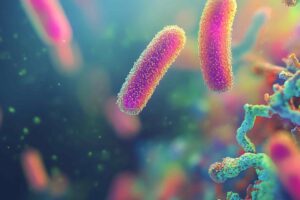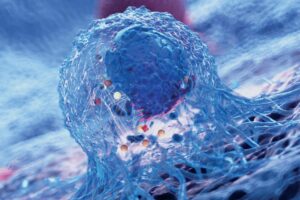What is already known
Autism spectrum disorder (ASD) is a condition affecting neurological development, causing a variety of cognitive, behavioral, and communication impairments. The disturbance of the connection between the gut and the brain, known as the gut-brain axis (GBA), has been implicated in ASD, although there is a lack of consistent findings across studies.
What this research adds
Researchers developed an algorithm to identify molecular and taxa profiles associated with ASD across various datasets. These datasets included information on microbiome, dietary patterns, metabolomics, cytokine profiles, and human brain gene expression. The findings revealed a functional structure within the GBA that correlates with the diverse phenotypes of ASD. This structure is characterized by specific amino acid, carbohydrate, and lipid profiles influenced by microbial species such as Prevotella, Bifidobacterium, Desulfovibrio, and Bacteroides. The structure also correlates with changes in brain gene expression, restrictive dietary patterns, and pro-inflammatory cytokine profiles. Importantly, the functional structure was not observed in the control cohort of patients, highlighting its specific association with ASD. Additionally, the study demonstrated a strong link between changes in microbiome composition over time and ASD phenotypes..
Conclusions
The authors propose a framework to leverage multi-omic datasets obtained from well-defined cohorts and to examine the impact of the GBA on ASD.
Autism spectrum disorder (ASD) comprises several neurodevelopmental disorders characterized by cognitive, behavioral, and communication impairments that emerge in early childhood. Although over 100 genes have been linked to ASD, most of the genetic variants are associated with heterogeneous phenotypes, making it challenging to pinpoint the specific molecular mechanisms responsible for particular impairments.
The gut-brain axis (GBA) facilitates the communication between the gut and the brain, maintaining brain homeostasis and regulating cognitive and emotional functions. Recent research has highlighted the important role of the gut microbiome, the vast population of microbes residing in the gut, in modulating the GBA and regulating neuroimmune networks, neural connections, and directly communicating with the brain.
Disruption of the gut microbiome and the GBA are believed to contribute to the pathogenesis of neurodevelopmental disorders, including autism. Due to the role that the GBA plays in the determination of neurodevelopmental disorders phenotypes, metagenomic and metabolic contributions of the gut microbiome should be considered as potential key components of the functional architecture, namely the network of interactions among different omic levels that determines individual phenotypes of autism.
To identify autism-specific omic profiles, Oldenburg and colleagues devised an algorithm to estimate the distribution of microbial differentials across multiple potential ASD subtypes taken from 25 omic datasets. Their work has been recently published in Nature Neuroscience journal.
By performing a multi-cohort and multi-omic meta-analysis combining omic datasets from different studies in one integrated analysis, the authors identified significant associations among various omic levels within the GBA, specifically of the microbiome in relation to ASD. Moreover, they presented a framework for future research aimed at elucidating the causal relationship between the microbiome, other omic levels, and ASD, ultimately contributing to a more precise understanding of these interconnections.
In the present study, children with ASD were individually paired with age-matched and sex-matched neurotypical control children within each study cohort. The microbial differential rankings estimated from 16S rRNA gene amplicon data from 7 age-matched and sex-matched cohorts against 15 other omic datasets, were cross-referenced to contextualize the potential functional roles that these microbes could play in autism.
Differential ranking analysis reveals strong ASD–microbiome links
By comparing 7 selected datasets, a comprehensive analysis that matched individuals based on their age and sex, was conducted. The results showed a clear separation in microbial composition between individuals with ASD and those without. Specifically, 591 microbes were more prevalent in children with ASD and 169 microbes in the control group, indicating clear microbial differences associated with ASD.
Strong microbial differences were observed between children with ASD and neurotypical children within age-matched and sex-matched cohorts, but not in the sibling-matched cohorts.
Log ratios of taxa were constructed from the age-matched and sex-matched differential abundance analysis, and strongly separated children with ASD from the neurotypical controls within each study. From these individual analyses, a single microbial log ratio was assembled, which highlighted a strong consistent enrichment of taxa in children with ASD relative to their control counterparts and this pattern was consistent across all age-matched and sex-matched cohorts.
ASD-specific patterns are present at several omic levels
Differential ranking analysis of different omic levels, specifically the microbiome and human transcriptome, revealed substantial and statistically significant distinctions between children with ASD and their age-matched and sex-matched neurotypical peers. However, the analysis of two additional omic levels, namely the metabolome and virome, did not show any significant findings.
Host cytokines correlate with microbial abundances
ASD has been consistently linked to immune dysregulation, which can manifest as various abnormalities such as the presence of “anti-brain” antibodies, disrupted cytokine profiles, or a family history of immune disorders. A recent studie showed that concentrations of the inflammatory cytokine transforming growth factor beta (TGF-β) are significantly elevated in children with ASD.
Re-analysis of this study dataset, after age matching and sex matching, revealed that the estimated microbial differentials were associated with TGF-β and positively correlated with the global microbial differences between ASD and control pairs. In contrast, the global microbial differences had little correlation with another inflammatory cytokine (interleukin (IL)-6) concentrations. However, the log ratios of the most differentiating microbial taxa were highly correlated with both TGF-β and IL-6 concentrations, indicating how IL-6 changes are linked to only few taxa, whereas TGF-β is linked to a much larger number of taxa.
Prevotella, Bacteroides and Bifidobacterium were predominantly associated with the cytokine differentials. Indeed, P. copri and Bacteroides fragilis both co-occurred with phages enriched in children with ASD or in neurotypical children, but, whereas microbes were previously reported to mediate viral infections, the mechanistic underpinnings of these interactions with the host’s immunity remain poorly understood.
Microbiome metabolism mirrors human brain metabolism in ASD
To investigate the possible interaction between the microbiome and the human brain, the metabolic abilities encoded by the microbial metagenome, which encompasses the individual metabolic capacities of thousands of different microbes, were compared with the differentially expressed human genome in the brain, two omic levels representing distinct biological contexts. 138 microbial and 1,772 human metabolic encoding genes were identified to be linked to ASD phenotype. 95 metabolic pathways in the human brain tissues, which were differentially expressed in individuals with ASD, had analogous microbial pathways differentially abundant in the microbiome of children with ASD, suggesting a potential coordination of metabolic pathways across omic levels in ASD.
Pathways related to amino acid, carbohydrate, and lipid metabolism were disproportionately represented among the overlapping pathways. When comparing the microbial enzyme-encoding genes associated with ASD to the previously identified gut-brain modules (GBMs), there was an approximate overlap of 48.5%, further supporting potential metabolic crosstalk across omic levels.
Microbiome metabolic capacity mirrors diet patterns in ASD
Previous studies have indicated a correlation between autistic traits in early childhood and poor diet quality in later stages of life. In the present study, a re-analysis of paired microbiome and dietary survey data was performed to investigate the relationship between diet quality and autistic traits.
By conducting a co-occurrence analysis of the microbiome and diet, amino acid, carbohydrate, and lipid metabolism association patterns were found similar to those observed in the analysis of microbiome-brain metabolic capacity. Autistic children were less likely to consume foods high in amino acids involved in neurotransmitter biosynthesis. Moreover, multiple Bacteroides and P. copri taxa were among the top 20 taxa, highlighting how they could be involved in metabolizing amino acid dietary compounds.
ASD microbiomes mirror behavior improvement after fecal matter transplant
The authors re-analysed the data from a 2-year, open-label fecal matter transplant (FMT) study involving 18 children with ASD, which suggested a potential role of the microbiome in improving autism symptoms, and found that all microbes associated with ASD in the 18 children before the FMT treatment were also ASD-associated microbes in the age-matched and sex-matched cross-sectional analysis of the present study. After 2 years, 91% of these microbes decreased in abundance, and this was significant in 57% of the microbes.
The authors also observed an increase in Prevotella sp. and Desulfovibrio piger over the 2-year span of the study and no significant changes in Bifidobacteria, whereas 305 taxa remained stable throughout the duration of the study. Of these, 13 taxa belonged to the Prevotella, Bifidobacterium, Bacteroides and Desulfovibrio lineages, pointing to a potentially wide functional diversity within these genera not noted in the original study.
Multiple butyrate producers in the Butyricimonas and Anaerobutyricum genera were also detected as being stable throughout the 2 years of the study, indicating a potential role in contributing to GBA homeostasis. Overall, the presence of this stable ‘core’ microbiome in combination with the depletion of most ASD-associated taxa, suggests a causal role for these microorganisms in shaping autism symptoms.
In conclusion, the present study revealed a clear separation between children with ASD and unrelated age-matched and sex-matched neurotypical controls, and this signal was validated using distinct methodologies across multiple cohorts.
Parallel analyses at the immunome, human transcriptome and dietome levels revealed strong associations among omic levels and the identification of several microorganisms consistently detected across omic levels, point to potentially interesting functional connections.
Based on their findings, the authors believe that multi-omic longitudinal intervention studies involving carefully selected cohorts, along with comprehensive patient metadata, would offer valuable opportunities to advance mechanistic research on GBA in ASD.











